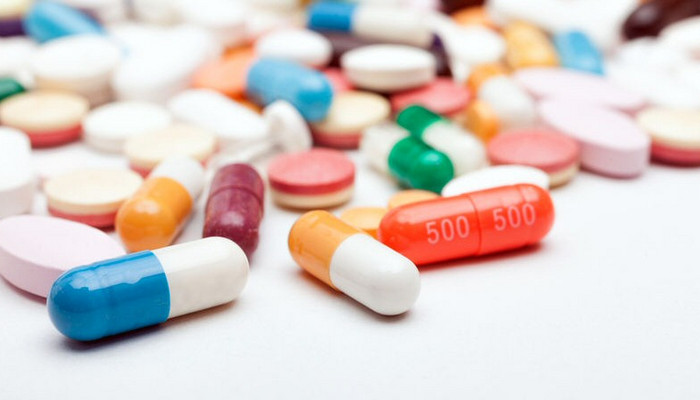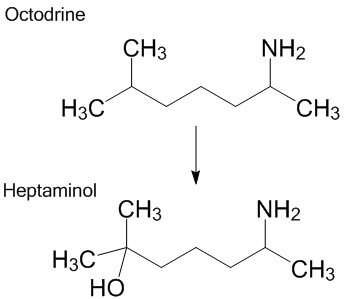Octodrine - ein dopingrelevantes Stimulanz

Octodrine (6-Methylheptan-2-amin bzw. 2-Amino-6-methylheptan, Strukturformel s. Abb.1) ist ein Stimulanz, das in den 50er Jahren gegen nasale Infekte entwickelt wurde. Als Medikament ist es nicht mehr im Handel. Es wird aber beobachtet, dass die Substanz illegal Nahrungsergänzungsmitteln zugesetzt wird.
Publikation
Catalani V, Prilutskaya M, Al-Imam A, Marrinan S, Elgharably Y, Zloh M, Martinotti G, Chilcott R, Corazza O. Octodrine: New Questions and Challenges in Sport Supplements. Brain Sci. 2018 Feb 20;8(2).
Download der Publikation
Über den Nachweis von Octodrine in Nahrungsergänzungsmitteln publizierte Cohen et al. erstmalig im Nov. 2017:
Cohen PA, Travis JC, Keizers PHJ, Deuster P, Venhuis BJ. Four experimental stimulants found in sports and weight loss supplements: 2-amino-6-methylheptane (octodrine), 1,4-dimethylamylamine (1,4-DMAA), 1,3-dimethylamylamine (1,3-DMAA) and 1,3-dimethylbutylamine (1,3-DMBA). Clin Toxicol (Phila). 2018 Jun;56(6):421-426. Epub 2017 Nov 8.
siehe Abstract
Wang M, Haider S, Chittiboyina AG, Parcher JF, Khan IA. 1,5-Dimethylhexylamine (octodrine) in sports and weight loss supplements: Natural constituent or synthetic chemical? J Pharm Biomed Anal. 2018 Apr 15;152:298-305. Epub 2018 Feb 8.
siehe Abstract
Folgende Informationen konnten am 9.10.2018 über
www.webmd.com/vitamins/ai/ingredientmono-1538/octodrine
abgerufen werden:
"Overview Information
Octodrine was originally used as drug for nasal congrestion. Today, octodrine is included as an ingredient in products used as dietary supplements to boost workout performance, "burn fat," or increase weight loss.Some products claim that octodrine comes naturally from aconite plants, but there is no clear evidence that octodrine can be found in these plants. It is likely that octodrine found in dietary supplements is made in a laboratory rather than produced from natural sources.Octodrine appears to be similar to another stimulant called dimethylamylamine (DMAA). DMAA has been removed from the market in certain countries due to safety concerns.
How does it work?
Octodrine is thought to have stimulant effects similar to decongestants such as pseudoephedrine, ephedrine, and others. Some promoters say that it is a safer alternative to ephedrine and dimethylamylamine. However, there is no scientific information to back up this claim."
Dopingrelevanz
Octodrin wird zurzeit von der Welt Anti-Doping Agentur (WADA) nicht als Beispiel auf der Verbotsliste zur Gruppe S6) Stímulanzien aufgelistet. Die Substanz wird aber als verwandte Verbindung eingestuft und ist deshalb für den Wettkampf verboten.
In der WADA-Statistik der weltweiten Dopingkontrollen wurde 2016 der erste positive Befund mit Octodrine aufgeführt.
Die Anti-Doping Agentur der USA warnt Athleten vor Nahrungsergänzungsmitteln mit Octodrine (25. Oktober 2018)
https://www.usada.org/octodrine/
siehe auch Artikel > Stimulanzien mit Alkylamin-Struktur
Metabolismus von Octodrine
Es ist von Interesse, dass Octodrine im menschlichen Stoffwechsel zu der Verbindung Heptaminol verstoffwechselt werden kann (Abb.1). Heptaminol steht namentlich auf der Verbotsliste. Bei positiven Befunden mit Heptaminol muss deshalb nicht zwingend davon ausgegangen werden, dass der Athlet Heptaminol angewendet hat, da auch Octodrine zu dem gleichen Befund führen kann.

(26.10.2018)